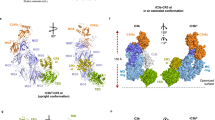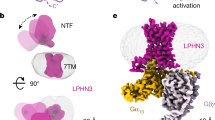Abstract
THE cell-surface glycoprotein vascular cell adhesion molecule-1 (VCAM-1; ref. 1) mediates intercellular adhesion2 by specific binding to the integrin very-late antigen-4 (VLA-4, α4β1; ref. 3). VCAM-1, with the intercellular adhesion molecules ICAM-1, ICAM-2, ICAM-3 and the mucosal vascular addressin MAd-CAM-1, forms an integrin-binding subgroup of the immuno-globulin superfamily. In addition to their clinical relevance in inflammation, these molecules act as cellular receptors for viral and parasitic agents2. The predominant form of VCAM-1 in vivo has an ammo-terminal extracellular region comprising seven immunoglobulin-like domains. Functional studies4-7 have identified a conserved integrin-binding motif in domains 1 and 4, variants of which are present in the N-terminal domain of all members of the immunoglobulin superfamily subgroup. We report here the crystal structure of a VLA-4-binding fragment composed of the first two domains of VCAM-1. The integrin-binding motif (Q38IDSPL) is highly exposed and forms the N-terminal region of the loop between β-strands C and D of domain 1. This motif exhibits a distinctive conformation which we predict will be common to all the integrin-binding IgSF molecules. These, and additional data, map VLA-4 binding to the face of the CFG β-sheet, the surface previously identified8 as the site for intercellular adhesive interactions between members of the immunoglobulin superfamily.
This is a preview of subscription content, access via your institution
Access options
Subscribe to this journal
Receive 51 print issues and online access
$199.00 per year
only $3.90 per issue
Buy this article
- Purchase on Springer Link
- Instant access to full article PDF
Prices may be subject to local taxes which are calculated during checkout
Similar content being viewed by others
References
Osborn, L. et al. Cell 59, 1203–1211 (1989).
Springer, T. A. Nature 346, 425–434 (1990).
Elices, M. J. et al. Cell 60, 577–584 (1990).
Osborn, L. et al. J. Cell. Biol. 124, 601–608 (1994).
Vonderheide, R. H., Tedder, T. F., Springer, T. A. & Staunton, D. E. J. Cell. Biol. 125, 215–222 (1994).
Renz, M. E. et al. J. Cell Biol. 125, 1395–1406 (1994).
Clements, J. M. et al. J. Cell Science 107, 2127–2135 (1994).
Jones, E. Y., Davis, S. J., Williams, A. F., Harlos, K. & Stuart, D. I. Nature 360, 232–239 (1992).
Bottomley, M. J. et al. J. molec. Biol. 244, 464–468 (1994).
Holden, H. M., Ito, M., Hartshorne, D. J. & Rayment, I. J. molec. Biol. 227, 840–851 (1992).
Harpaz, Y. & Chothia, C. J. molec. Biol. 238, 528–539 (1994).
Wang, J. et al. Nature 348, 411–418 (1990).
Ryu, S-E. et al. Nature 348, 419–426 (1990).
Staunton, D. E., Dustin, M. L., Erickson, H. P. & Springer, T. A. Cell. 61, 243–254 (1990).
Holness, C. L. et al. J. biol. Chem. (in the press).
Bodian, D. L., Jones, E. Y., Harlos, K., Stuart, D. I. & Davis, S. J. Structure 2, 755–766 (1994).
Komoriya, A. et al. J. biol. Chem. 266, 15075–15079 (1991).
Cardarelli, P. M. et al. J. biol. Chem. 269, 18668–18673 (1994).
Logan, D. et al. Nature 362, 566–568 (1993).
Leahy, D. J., Hendrickson, W. A., Aukhil, I. & Erickson, H. P. Science 258, 987–991 (1992).
Dudgeon, T. J. et al. Eur. J. Biochem. 226, 517–523 (1994).
Jones, A. Meth. Enzym. 115, 157–171 (1985).
Kabsch, W. & Sander, C. Biopolymers 22, 2577–2637 (1983).
Leahy, D. J., Axel, R. & Hendrickson, W. A. Cell 68, 1145–1162 (1992).
Saul, F. A., Amzel, L. M. & Poljak, R. J. J. biol. Chem. 253, 585–597 (1978).
Kraulis, P. J. J. appl. Crystallogr. 24, 945–949 (1991).
Stuart, D. I., Levine, M., Muirhead, H. & Stammers, D. K. J. molec. Biol. 134, 109–142 (1979).
Nicholls, A., Sharp, K. A. & Honig, B. Proteins 11, 281–296 (1991).
Author information
Authors and Affiliations
Rights and permissions
About this article
Cite this article
Jones, E., Harlos, K., Bottomley, M. et al. Crystal structure of an integrin-binding fragment of vascular cell adhesion molecule-1 at 1.8 Å resolution. Nature 373, 539–544 (1995). https://doi.org/10.1038/373539a0
Received:
Accepted:
Issue Date:
DOI: https://doi.org/10.1038/373539a0
This article is cited by
-
The γδTCR combines innate immunity with adaptive immunity by utilizing spatially distinct regions for agonist selection and antigen responsiveness
Nature Immunology (2018)
-
Adhesion molecules in peritoneal dissemination: function, prognostic relevance and therapeutic options
Clinical & Experimental Metastasis (2016)
-
Emerging paradigms of integrin ligand binding and activation
Kidney International (1997)
-
Crystal structure of ICAM-2 reveals a distinctive integrin recognition surface
Nature (1997)
Comments
By submitting a comment you agree to abide by our Terms and Community Guidelines. If you find something abusive or that does not comply with our terms or guidelines please flag it as inappropriate.



